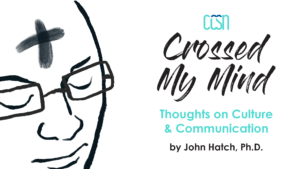 Crossed My Mind: Thoughts on Culture and Communication
Crossed My Mind: Thoughts on Culture and Communication
By John Hatch, Ph.D.
Eastern University (retired)
CCSN Senior Fellow
Column Description: As Christians, we are called to have the mind of Christ. This goes against the grain of our social and cultural conditioning. We seek personal or political advancement; Christ seeks the lost and the least. We grasp for cultural ascendency; Christ descends to the cross of love. This column is dedicated to thinking about culture and communication under the sign of the cross.
November 2022 / October 2022 / August-September 2022 / June-July 2022 / January 2022 / December 2021 / October-November 2021
Beyond Racial Division: Truth, the Gospel, and Yancey’s Third Way
In my last column, I took a brief look at author Frederick Buechner’s approach to “telling the truth,” modeled after what he saw in the biblical gospel: a messy and miraculous blend of realism, tragedy, comedy, and fairytale.
This full-orbed account of gospel truth parallels the psalmist’s rich and rounded picture of shalom in the kingdom of God, where faithful truth, righteous justice, harmonious peace, and merciful grace come together in fourfold embrace.[i] On closer observation, the literary frames identified by Buechner loosely correspond with these four values. Realism is faithful to the truth of tested facts and experience. Tragedy is driven by implacable justice. Comedy disarms enemies by poking behind their masks and blinders to reveal common humanity and make way for peace. Fairytale features the miraculous working of divine grace.
God’s revelation in Christ helps us see our predicament through all of these lenses together, increasing our depth perception on human affairs. If we let it transform us deeply, we will have a new, more capacious mindset, not only toward God and neighbor, but the world and its problems.
For example, race is an issue that deeply divides society and the church. It seems we are lost in one-dimensional disagreements and fruitless debates over the nature, extent, and impact of racism. Meanwhile, racialized disadvantages, divisions, and recriminations fester like undressed wounds. As a scholar who has studied race and reconciliation for two decades, this concerns me deeply.
It also greatly concerns George Yancey—a black Christian sociologist who has extensively studied both racial division and anti-Christian prejudice. In his latest book, Beyond Racial Division: A Unifying Alternative to Colorblindness and Antiracism, Yancey laments: “Many of us are tired of fighting the same racial battles over and over again . . . . We are tired of hearing the same arguments and getting nothing done. Those who endorse colorblindness immediately blame those who want to be proactive in dealing with racial issues. Those with an antiracism mindset blame those who are not as active as they are. Those groups talk past each other.”[ii]
While truth involves an element of faithfulness (faithful to one’s word, to the facts, etc.), it misses the mark when reduced to faithfulness to one’s ideology or loyalty to one’s tribe. Yancey’s approach to race aims to be faithful to the whole truth, as revealed by God and sound scientific study, with a view to redemption in the church and society.
As such, Yancey unflinchingly faces human reality and the tragedy of sin, starting with himself: “no matter how good my approach [to race], I must also recognize that I am part of the problem.”[iii] Yancey explains: “My society has instilled . . . ethnocentrism within me, and I learned those lessons well. I contribute to the racial alienation plaguing our society, and unless I take deliberate steps to do otherwise, I will always be more part of the problem than the solution.”[iv] Neither one’s race nor one’s ideology exempts one from critique.
When examining the competing approaches of colorblindness and antiracism, Yancey prioritizes factual evidence, which turns out to work for and against both approaches. With regard to the colorblind approach to race, he acknowledges how racism has become strongly stigmatized over the last five decades, which might make it seem a marginal issue today; yet he also highlights the tragic persistence of systemic barriers for people of color, as evidenced by residential segregation (stemming from past racist policies), institutional discrimination (in the criminal justice system, word-of-mouth hiring, and access to transportation), and studies of individual racial bias. Given these realities, simply ignoring racial difference won’t do.
Turning to antiracism, Yancey gives it the same even-handed, fact-based treatment. He begins by acknowledging that the antiracist camp gets a lot right about the persistent problem of racial injustice. However, he then discusses evidence indicating that antiracism’s solutions to this problem don’t actually work: diversity training has little long-term effect on prejudice, and programs that treat white people like schoolchildren (rather than dialogue partners) provoke backlash. Yancey confesses: “Part of me wants antiracism efforts to succeed, but they simply don’t.”[v] He also acknowledges that some high-profile cases of racial injustice turn out not to be race-based after all, yet antiracists tend to stick to their narrative rather than adjusting it to fit the facts.
While Yancey is a realist, he’s certainly not neutral about race; his work is motivated by deep moral commitments to justice and peace. This means he views barriers to racial equality as tragic consequences of human sin that must be rectified; yet at the same time he refuses to demonize anyone. Rather, Yancey sees common humanity across opposing parties, prone to error yet redeemable as agents for the common good. He desires to see racial injustice rectified, yet proposes a “unifying alternative” to accomplishing this. In his “mutual accountability” approach, blacks and whites (and other races) must face the tragedy of persistent injustice together, engage in dialogue about it, listen to one another, and collaborate to find win-win solutions.
Mutual accountability is grounded in Yancey’s theological understanding of the gospel: that sin is at work in all of humanity, inclining us to address others in a self-seeking manner, yet God in Christ has selflessly loved us and redeemed us from our sin, calling us follow suit. The implication for race relations is that all of us should be open to challenges and correction about our biases and prejudices. In addition, we should consider the interests of the out-group, not just our in-group, when deciding on policies; should rely on moral suasion rather than power to change others’ behavior; and should treat one another as partners in the work of justice and reconciliation.
If Beyond Racial Division shortchanges any aspect of gospel truth, it may be the “fairytale” dimension. Yancey gives more attention to human depravity and God’s call to seek others’ good than Christ’s miraculous reconciling power. This focus appears to be somewhat intentional: Christians often focus on individual salvation and supernatural power while overlooking the anthropological and social implications of the gospel, which leads them to argue, incorrectly, that racial justice is a distraction or detraction from Christian faith.
Although Yancey believes Scripture supports a mutual accountability model, his commitment to the whole truth leads him to ask whether there is empirical evidence for the viability of the approach. Although there has been no direct research to date on applying this model to racial bias, Yancey cites several studies showing the effectiveness of collaborative-conversational approaches to solving problems, including racial inequality in organizations. He also gives examples of individuals who have made a journey from racial passivity, to antiracism, to promoting collaborative interracial conversations, and highlights an organization that has made important strides in improving relations between law enforcement officers and people of color through the latter approach.[vi]
It should be noted that while I commend Yancey’s gospel-shaped commitment to truth about race, I am not claiming that he gives us “The Gospel Truth” on this subject—nor does the author himself. In fact, throughout Beyond Racial Division, he admits that he could be wrong on certain points and more research is needed.
One thing Yancey doesn’t address is the possibility of a redeemed form of antiracism. This is rather surprising, considering that he largely agrees with two of its three central tenets. The abolitionist movement of the 1800s was both adamantly anti-slavery and deeply grounded in Christian faith. Although slavery is far removed in time and severity from today’s racial inequalities, we might reasonably ask: Could there be a gospel-shaped version of antiracism—passionate yet humble, confident yet collaborative in its approach to addressing systemic racism?
My next column will take up this question.
Notes
[i] Psalm 85:10. I used two-word phrases here in order to somewhat capture the range of ways in which these four qualities are translated in different English Bible versions.
[ii] George A. Yancey, Beyond Racial Division: A Unifying Alternative to Colorblindness and Antiracism (Downers Grove, IL: Intervarsity Press, 2022), 3.
[iii] Yancey, Beyond Racial Division, 9.
[iv] Yancey, Beyond Racial Division, 10.
[v] Yancey, Beyond Racial Division, 94.
[vi] The organization is called Game Changer (see https://gamechanger1.org/).

